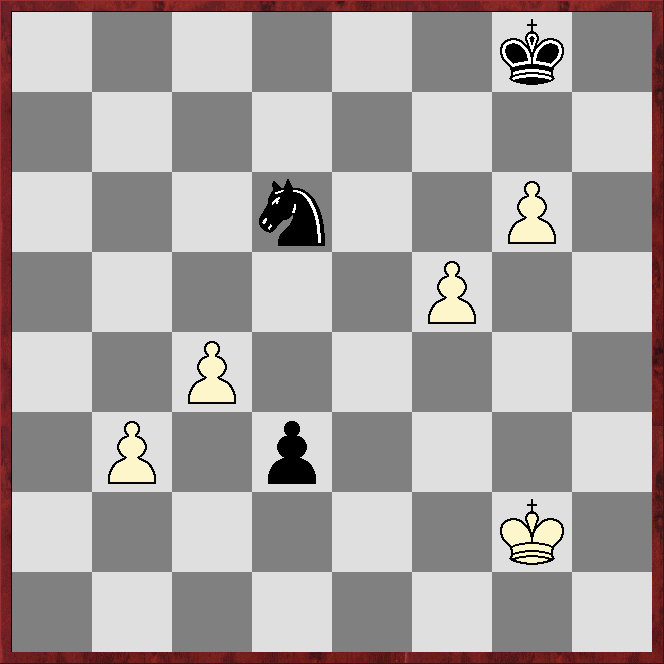Modern
1.e4 d6 2.d4 g6 3.Nc3 Bg7 4.f4 Nc6!?
This is fourth in popularity in ChessBase's 2024 Mega database behind 4...c6, 4...a6 and especially 4...Nf6.
*****
*****
*****
*****
5.d5!?
This has been played by grandmasters, but Stockfish16.1 and Dragon1 prefer 5.Nf3 and, even more so, 5.Be3.
5...Nb8
Slightly more popular is 5...Nd4!?
6.Nf3 Bg4!?
The engines strongly dislike this, favouring 6...c6.
7.h3 Bxf3 8.Qxf3 Nd7 9.Bc4!?
This may be a novelty; known moves are 9.Bb5 and 9.Be3.
9...Ngf6 10.0-0 0-0
9...Ngf6 10.0-0 0-0
*****
*****
*****
*****
White's bishop-pair and space advantage in the centre and on the kingside look impressive, but the engines only give White a slight edge, presumably because they believe Black is reasonably well-placed to exert counterplay.
11.Be3 c6 12.a4 c5?!
The engines strongly dislike this, reckoning it gives White a positionally won game. They recommend 12...cxd5, followed by pressure against the white queenside.
13.Rae1 a6 14.Bd2!?
This retreat is the engines' top choice, along with 14.Kh1.
14...Ne8 15.g4 Nc7 16.g5 Rb8 17.a5
The engines prefer playing on the kingside with 17.h4 or 17.Be2!?
17...b5 18.axb6 Rxb6 19.b3 Nb5 20.Nxb5 axb5 21.Bd3!?
The engines reckon 21.Be2 keeps an advantage.
21...Rb8
The engines suggest 21...c4!? 22.bxc4 bxc4 23.Bxc4 Qc7, claiming Black has full compensation for a pawn. They also like 21...Qc7, reckoning 22.c4 bxc4 23.Bxc4!? is completely equal.
22.h4 Qc7 23.Qe2 Qb7
The engines suggest 23...c4!? 24.bxc4 bxc4 25.Bxc4 Bd4+ and 26...Rb2, again claiming Black has good compensation for a pawn.
24.Rb1 b4?!
Closing the queenside leaves White with more-or-less a free hand on the kingside.
25.h5 Ra8 26.Kh2 Nb6?!
This may be too slow. The engines give 26...Ra2, albeit awarding White the upper hand.
27.Rbd1 e6?
Counterplay is necessary, but not this way, according to the engines. They again give ...Ra2.
28.hxg6 exd5 29.exd5?
Capturing with check on h7 or f7 is much stronger, according to the engines.
29...Rae8?
The engines reckon Black should capture on g6, probably with the f pawn.
30.gxf7+ Qxf7 31.Qf3 Nd7!?
Capturing on d5, either way, loses to 32.Bc4.
*****
*****
*****
*****
32.Qg4 Nb6 33.g6!? Qxd5
*****
*****
*****
*****
34.Bxb4!?
This is sound, but even stronger are 34.Rg1 and especially 34.f5!?, according to the engines.
34...Qc6?!
The engines reckon Black should 'fall' for the combination by playing 34...cxb4!?, although 35.Bc4 Nxc4 36.Rxd5 Ne3 37.Qf3 Nxf1+ 38.Qxf1 leaves Black with insufficient compensation for a queen.
35.Qh5?
Much stronger is 35.gxh7+ Kh8 36.Rg1!?
35...h6 36.Bd2
*****
*****
*****
*****
36...d5 37.f5!? c4
*****
*****
*****
*****
38.Bxh6!
This is much stronger than 38.Be2, after which Black starts to get active with 38...Re5, eg 39.Bxh6? allows 39...Bxh6 40.Qxh6 Rxe2+.
38...cxd3!? 39.Rxd3?
This throws away all of White's advantage. Best is 39.Bxg7 Qc7+ 40.Kh1 Qxg7 41.f6! Rxf6 42.Rxf6 Qxf6 43.Qh7+ Kf8 44.g7+ Ke7 45.g8=N+!? (45.g8=Q also wins) Kd6 46.Nxf6 etc.
39...Bxh6 40.Qxh6 Re2+ 41.Kh3 Qc7 42.Rg3 Qg7
39...Bxh6 40.Qxh6 Re2+ 41.Kh3 Qc7 42.Rg3 Qg7
*****
*****
*****
*****
Neither side, according to the engines, although the position remains sharp.
43.Qh4 Re4
Not 43...Qh8?? 44.Qxh8+ Kxh8 45.g7+.
44.Qh5 Rf6 45.c4!? d4!? 46.Kg2 Nd7 47.Qf3?!
The engines reckon 47.Rh1 and 47.c5 maintain equality.
*****
*****
*****
*****
47...Qe7
Black is at least slightly better after 47...Re5!?, according to the engines, although they disagree how to continue after 48.Qh5 Nf8 49.Qg4.
48.Rf2?
Best may be 48.Qh5, when 49.g7 is a serious threat.
48...Qe5??
Now White is winning, whereas 48...Ra6, with ...Ra1 and ...Nf6 threatened, wins for Black, according to the engines (they also reckon 48...Rc6 gives an advantage). Best play after 48...Ra6 might continue 49.c5 Nf6 50.Qd3 Ra1 51.Qc4+ Kg7, after which White seems to have nothing better than 52.Qf7+!? Qxf7 53.gxf7+ Kxf7, when Black's material advantage, combined with White's weak pawns, should tell.
49.Rh3?
Winning is 49.Qh5 with g7 to come.
49...Rd6 50.Qh5
A move too late as Black has ...
50...Qg7
... after which the engines call the game completely equal, although again it remains sharp.
51.Ra2 Nf6 52.Ra8+ Re8 53.Rxe8+ Nxe8 54.Qf3 d3 55.Qe4!
The only move that holds the balance.
55...Qd7 56.Rh7 Nf6!?
Prompting liquidation into an ending that only White can win, but which is fairly easily drawn.
57.Rxd7 Nxe4 58.Rxd6 Nxd6
*****
*****
*****
*****
59.Kf2 Nxf5 60.Ke1 Kg7 61.Kd2 Kxg6 62.Kxd3 Kf6 63.Ke4 Ke6 64.b4 Nd6+ 65.Kd4 Nb7 66.c5 Kd7 67.Kc5 Kc7
JK offered a draw in my time.
68.c6 Nd8 69.b5 Kb6
69...Nxc6 70.bxc6 Kc8 is a drawn pawn-ending.
70.Kd6 Nf7+
Also drawing is 70...Nb7+!?
71.Kd7 Ne5+ 72.Kd6 Nf7+ 73.Ke6 Ng5+ 74.Kd7 Ne4 75.c7 Nc5+ 76.Kd6 Nb7+ ½–½









No comments:
Post a Comment